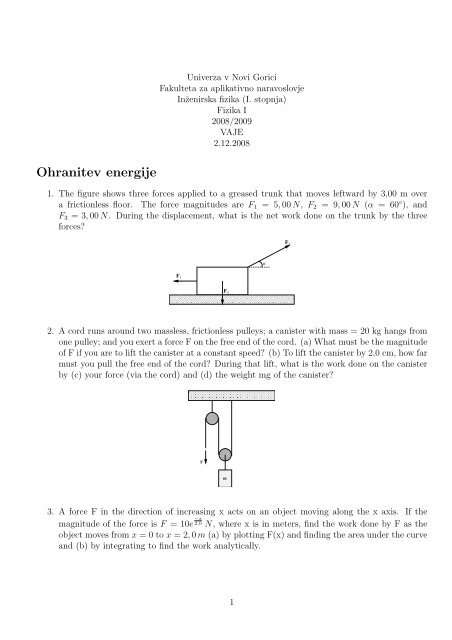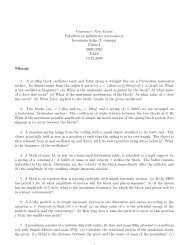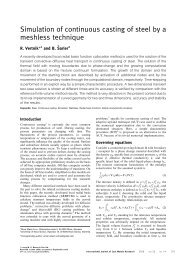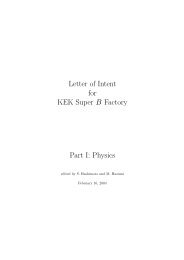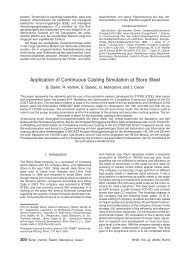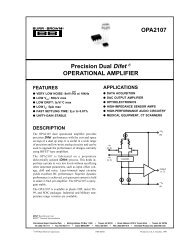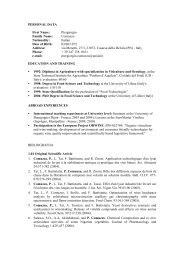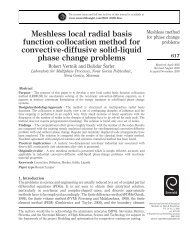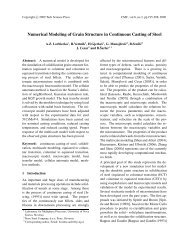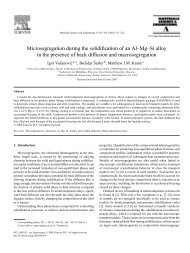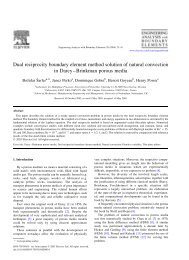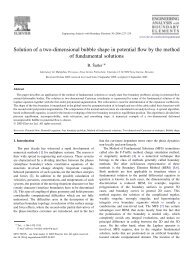Ohranitev energije - Univerza v Novi Gorici
Ohranitev energije - Univerza v Novi Gorici
Ohranitev energije - Univerza v Novi Gorici
You also want an ePaper? Increase the reach of your titles
YUMPU automatically turns print PDFs into web optimized ePapers that Google loves.
<strong>Ohranitev</strong> <strong>energije</strong><br />
<strong>Univerza</strong> v <strong>Novi</strong> <strong>Gorici</strong><br />
Fakulteta za aplikativno naravoslovje<br />
Inˇzenirska fizika (I. stopnja)<br />
Fizika I<br />
2008/2009<br />
VAJE<br />
2.12.2008<br />
1. The figure shows three forces applied to a greased trunk that moves leftward by 3,00 m over<br />
a frictionless floor. The force magnitudes are F1 = 5, 00N, F2 = 9, 00N (α = 60 ◦ ), and<br />
F3 = 3, 00N. During the displacement, what is the net work done on the trunk by the three<br />
forces?<br />
F<br />
000000000000<br />
111111111111 2<br />
000000000000<br />
111111111111<br />
000000000000<br />
111111111111<br />
000000000000<br />
111111111111<br />
000000000000<br />
111111111111<br />
000000000000<br />
111111111111<br />
α<br />
000000000000<br />
111111111111<br />
1<br />
00000000<br />
11111111<br />
01<br />
01<br />
01<br />
01<br />
F3<br />
01<br />
00000000000000000000000000000000000<br />
11111111111111111111111111111111111<br />
01<br />
00000000000000000000000000000000000<br />
11111111111111111111111111111111111<br />
01<br />
00000000000000000000000000000000000<br />
11111111111111111111111111111111111<br />
01<br />
2. A cord runs around two massless, frictionless pulleys; a canister with mass = 20 kg hangs from<br />
one pulley; and you exert a force F on the free end of the cord. (a) What must be the magnitude<br />
of F if you are to lift the canister at a constant speed? (b) To lift the canister by 2,0 cm, how far<br />
must you pull the free end of the cord? During that lift, what is the work done on the canister<br />
by (c) your force (via the cord) and (d) the weight mg of the canister?<br />
00000000000000000000000000<br />
11111111111111111111111111<br />
00000000000000000000000000<br />
11111111111111111111111111<br />
00000000000000000000000000<br />
11111111111111111111111111<br />
00000000000000000000000000<br />
11111111111111111111111111<br />
F<br />
m<br />
3. A force F in the direction of increasing x acts on an object moving along the x axis. If the<br />
magnitude of the force is F = 10e −x<br />
2,0 N, where x is in meters, find the work done by F as the<br />
object moves from x = 0 to x = 2, 0m (a) by plotting F(x) and finding the area under the curve<br />
and (b) by integrating to find the work analytically.<br />
1<br />
F
4. The only force acting on a 2,0 kg body as it moves along the positive x axis has an x component<br />
Fx = −6xN, where x is in meters. The velocity of the body at x = 3, 0m is 8,0 m/s. (a) What<br />
is the velocity of the body at x = 4, 0m? (b) At what positive value of x will the body have a<br />
velocity of 5,0 m/s?<br />
5. A man racing his son has half the kinetic energy of the son, who has half the mass of the father.<br />
The man speeds up by 1,0 m/s and then has the same kinetic energy as the son. What were<br />
the original speeds of man and son?<br />
6. A 2,00 kg block is placed against a spring on a frictionless 30,0 ◦ incline. The spring, whose<br />
spring constant is 19,6 N/cm, is compressed 20,0 cm and then released. (a) What is the elastic<br />
potential energy of the compressed spring? (b) What is the change in the gravitational potential<br />
energy of the block-Earth system as the block moves from the release point to its highest point<br />
on the incline? (c) How far along the incline is the highest point from the release point?<br />
7. A 3,5 kg block is accelerated by a compressed spring whose spring constant is 640 N/m. After<br />
leaving the spring at the spring’s relaxed length, the block travels over a horizontal surface, with<br />
a coefficient of kinetic friction of 0,25, for a distance of 7,8 m before stopping. (a) How much<br />
mechanical energy was dissipated by the frictional force in stopping the block? (b) What was the<br />
maximum kinetic energy of the block? (c) Through what distance was the spring compressed<br />
before the block began to move?<br />
m<br />
8. A block slides along a track from one level to a higher level, by moving through an intermediate<br />
valley. The track is frictionaless until the block reaches the higher level. There a frictional force<br />
stops the block in a distance d. The block’s initial speed v0 is 6,0 m/s; the height difference h<br />
is 1,1 m; and the coefficient of kinetic friction k is 0,69. Find d.<br />
m<br />
v<br />
9. A uniform rod of mass 1,5 kg is 2,0 m long. The rod can pivot about a horizontal, frictionless<br />
pin through one end. It is released from rest at an angle of 40 ◦ above the horizontal. (a) What<br />
is the angular acceleration of the rod at the instant it is released? (The rotational inertia of the<br />
rod about the pin is 2,0 kg m 2 ) (b) Use the principle of conservation of energy to determine the<br />
angular speed of the rod as it passes through the horizontal position.<br />
α<br />
2<br />
h
10. The rigid body shown in the firgure consists of three particles connected by massless rods. It<br />
is to be rotated about an axis perpendicular to its plane through point P. If M = 0, 40kg,<br />
a = 30cm, and b = 50cm, how much work is required to take the body from rest to an angular<br />
speed of 5,0 rad/s?<br />
b<br />
M<br />
a a<br />
2M P<br />
2M<br />
11. An initially stationary 2,0 kg object accelerates horizontally and uniformly to a speed of 10 m/s<br />
in 3,0 s. (a) In that 3,0 s interval, how much work is done on the object by the force accelerating<br />
it? What is the instantaneous power due to that force (b) at the end of the first half of the<br />
interval?<br />
12. A fully loaded, slow-moving freight elevator has a cab with a total mass of 1200 kg, which is<br />
required to travel upward 54 m in 3,0 min. The elevator’s counterweight has a mass of only 950<br />
kg. So, the elevator motor must help pull the cab upward. What average power (in horsepower)<br />
is required of the force that the motor exerts on the cab via the cable?<br />
3<br />
b


